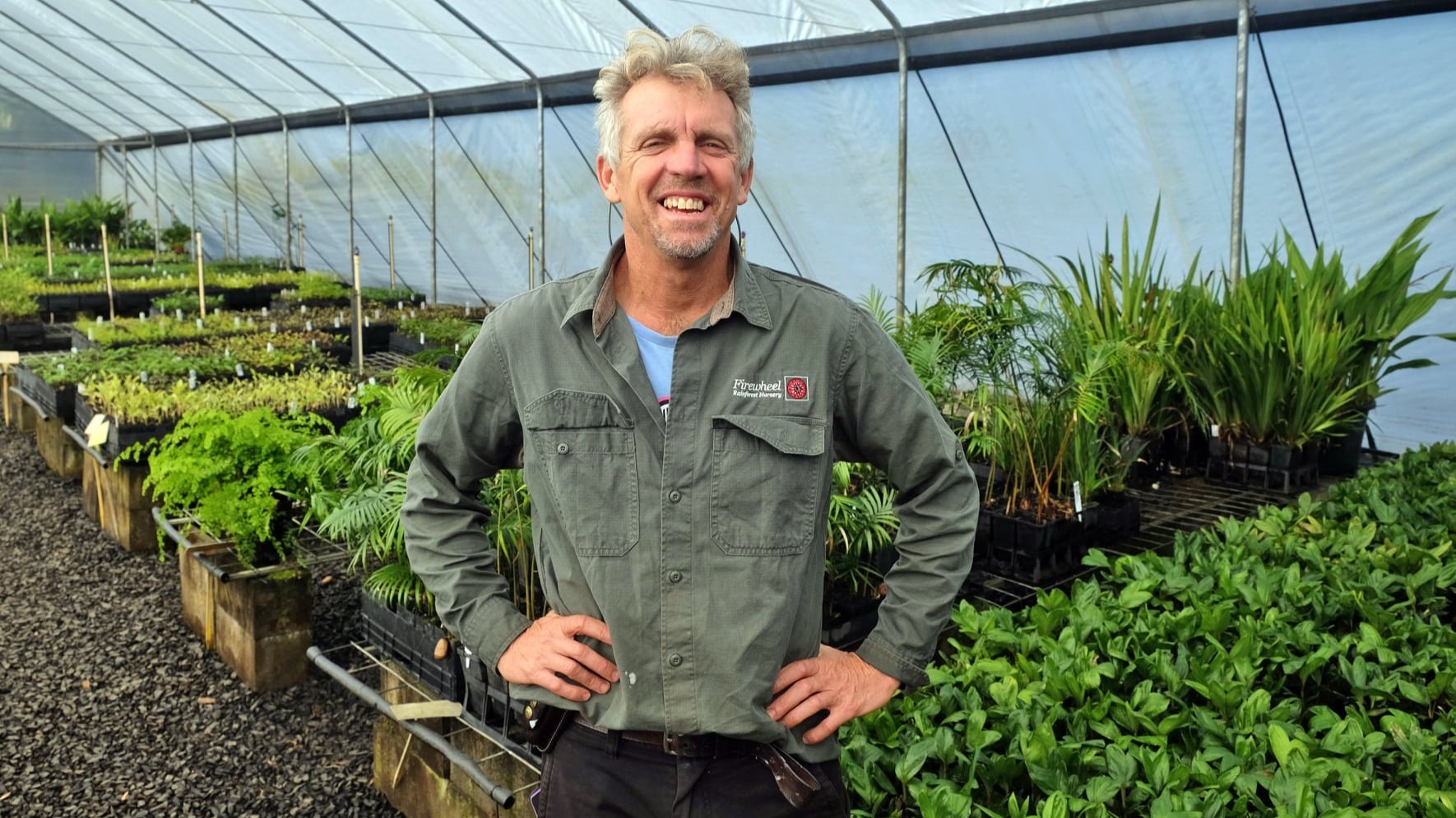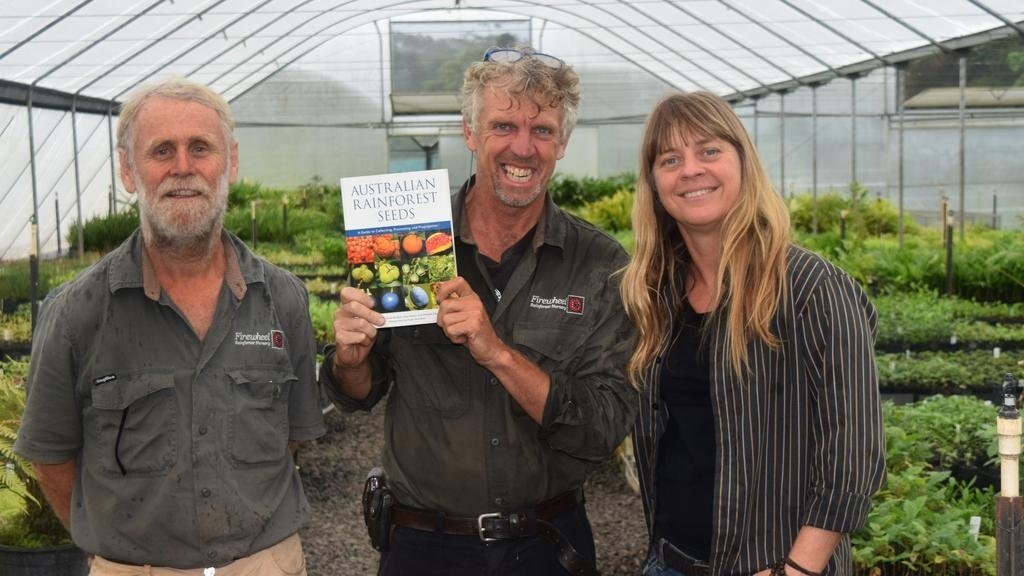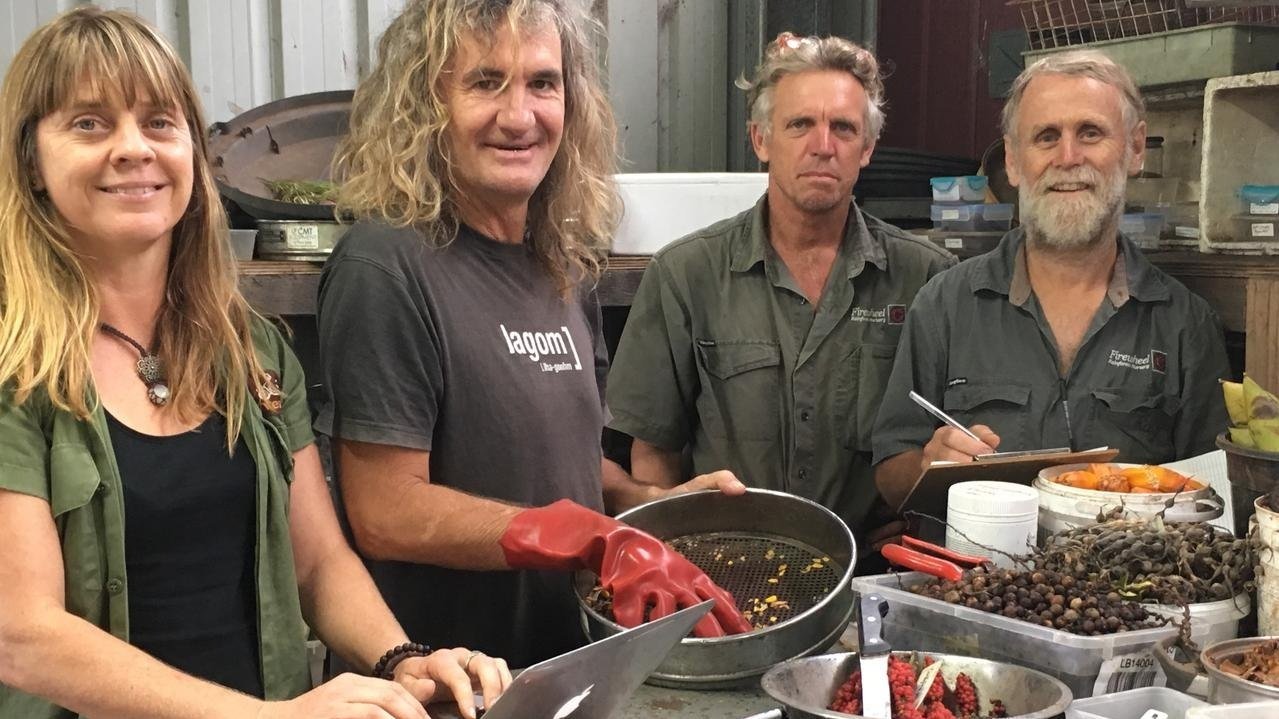Connecting with the Web of Life: Mark Dunphy Rainforest Conservator
I love to move my feet through the leaf litter and see the humus developing and imagine all the micro-organisms in the soil. You really feel like you've got a system going. That feels so good, really good. Seeing the Wompoo pigeons in the Bangalow palms that you've planted that were never there before in the forest , it certainly gives you a feeling of connecting to nature.
Mark Dunphy has been involved in rainforest regeneration and conservation for nearly 40 years and has developed an extensive knowledge of the practicalities of regenerating subtropical rainforest in the Big Scrub region. Welcoming you with a big smile to Firewheel Nursery you know you will leave with not only healthy plants but advice which comes from years of on the ground research and experimentation. This is driven by Mark’s passion to reafforest our region with the rainforest indigenous to our area and to bring back the flora and fauna which cohabited in what was once the Big Scrub.
Conservation in his genes
Mark not only has conservation in his heart but in his genes. Mark shares his initials with his grandfather and his uncle, in their time both giant environmentalists. As a boy Mark developing a deep love and understanding of the natural world, walking the trails his grandfather had mapped out in what later became the Blue Mountains National Park. Myles Dunphy was known as the NSW Father of Conservation. Mark’s uncle Milo was a more modern conservationist at the forefront of environmental activism in the 1970s and 80s.
Mark says it took him some time to find his own path in the arena of conservation, but he describes a green-light moment when he discovered bush regeneration. Curiously, what he saw as a minor disability, qualified him to work as a bush regenerator with an employment agency, and that became the catalyst for an enduring passion, starting off a life in rainforest conservation.
I loved bush regeneration because you could use science, but you're also getting your hands dirty and manipulating the environment to create and to bring back the bush. We discovered you could regenerate the bush by mostly just removing weeds. So that was basically the big green light for me and I just went, this is it for me.
Mark says that nearly 40 years later he still gets a kick out of understanding the ecology of rainforest and doing something to get what is left of it moving and functioning as a forest.
The Big Scrub
The Big Scrub was an area 75,000 hectares of lowland subtropical rainforest remaining in eastern Australia after Australia separated from Gondwanaland. By the early 1900s. following land clearing, only 100 small unconnected remnants remained in the Northern Rivers. Despite being overgrown by vines and weeds these remnants offered a connection with the great forests of Gondwanaland. Around 400 plant species were identified, some having lineages going back millions of years and many endangered. While Mark sees the remnants as precious antiques, the diversity of plants in the remnants informed future plantings.
I see them as museum pieces, like antiques which are references to what has been and what could be.
These precious remnants that were rapidly degrading were the inspiration for the formation of the volunteer organisation, the Big Scrub Rainforest Landcare group in 1993 (now the Big Scrub Rainforest Conservancy). Mark was a formation member and current Vice President. Tony Parkes has been the President for the 30 years since the group begin. He says of Tony that he initially seemed an unlikely champion of rainforest but through his experience as an investment banker attracted millions of dollars and a great team of people to research, restore remnants and plant millions of trees. Mark describes him as a friend, mentor and father figure who he loves and cares for.
He's run the Landcare group like the CEO of a large organisation and dedicated over 40 volunteer hours a week from the time of his retirement at 56, dedicating the rest of his life to the Landcare group.
The science of rainforest restoration
In the early years Mark worked together with Len Webb, an inspiring botanist and ecologist, and Rob Kooyman,
In the early years Mark was inspired by leading ecologist Len Webb and worked closely with local botanist and ecologist Robert Kooyman, whom he describes as having a brain as big as a planet. They researched, experimented with planting methods, and found the high density, high diversity plantings highly successful in replanting rainforest from a bare paddock.
Initially BSLG concentrated on rehabilitating the remnants on both public and private land, and in a secondary phase extended the remnants, planting trees to create rainforest from a bare paddock.. This is where Firewheel Nursery came in, producing the wide variety of plants needed for these plantings. It was a huge learning curve, each species unique in its seeding, seed dispersal, germination, planting and growth requirements in terms of soil, sunshine and moisture. By trial and error, and sharing information with other nurseryfolk and regenerators, and aligning himself with experts in seed collection and propagation, Mark has now developed methods of optimising production at each stage for all the species needed, a far contrast to thirty years ago when failures of seed germination was the normal result.
And now I look back at the nursery that we had then and I think, well, no wonder nothing germinated because it was dark and wet and we planted the seeds too deeply and we collect them at the wrong time.
The collection of healthy seeds is vital to the process. Mark says seed collecting is a highly skilled job and he can count expert seed collectors on the fingers of one hand. They need to know their plant species - what the tree looks like, where they grow in the environment, when they flower and drop seeds, and the best conditions for collecting, germinating and propagation.
The best of them are a bit crazy. They need to have a good connection to the land, be able to think like a rainforest, understand seed biology and be a bit obsessive about cracking the codes of germination.
Mark says it is sometimes complete chance. He tells the amusing story of Paul who found it impossible to germinate fruits of a particular rainforest tree, wrapped them in plastic on the dashboard of the car for weeks and bingo they all germinated.
Inspiring regeneration
Together with BSLG, all the experience Mark and experienced regenerators and seed collectors have gained, has been published in two books: "Sub-Tropical Rainforest Regeneration" and ""Australian Rainforest Seed". These books are now considered invaluable texts for any aspiring planters and regenerators in our region.
People love the books. We've sold thousands of copies and people think they are fantastic. So I am very proud of those 40 years of collating and persisting. We've cracked most of the basics, so while there is certainly more to learn and many more questions, we basically know how to regenerate nearly everything now.
While they could be considered as trade secrets Mark feels the bigger picture is the goal.
I feel that most of us have the big picture in mind, and the big picture is to regenerate the Big Scrub as best as possible.
At the same time local land-care groups and private land owners using the experience of BSRLG have planted even more trees. Mark says the trajectory of planting in the Big Scrub is reflected in how many rainforest trees are going in the ground.
In the 1980s, hundreds of trees was a big planting, then in the nineties we were planting thousands, in the early 2000’s we were planting tens of thousands and now we're planting hundreds of thousands.
Many landowners come to Mark for advice on how to achieve their dreams of creating a rainforest. With nearly 40 years of experience, Mark is happy to share advice. He will often go on a site visit to advise how, what and where to plant. He jokes that he would rather be a nursery man than a car mechanic as his clients love visiting the nursery, stay for a chat, spend $1,000 dollars on trees and leave with a smile on their faces.
I have many customers that I've developed over time who have bought trees, planted them, grown them, and then want to come back and tell me how fantastic the planting is going and, sometimes, how each tree is growing.
It is important for land owners to know the nature and topography of the land being planted, to know what was there before and to select plants most likely to survive and thrive in that environment. Mark tries as far as possible to match regenerators with the needs of the landowner. He encourages them to plant initially in a place they can frequently watch over the progress of their trees and to set up walking tracks so they can become immersed in their forest and become excited watching their trees grow and the rainforest emerging.
I certainly discovered over the years is that it is about people and people's connection with their piece of land or people's connection with the region that will eventually make the difference.
Through the example of the BSRC, their dedication, their field days, their workshops and their publications they have enthused others with their passion and infectious enthusiasm. Mark himself – scientist, bush regenerator, seed collector and propagator, nurseryman, author and teacher, has been at the forefront of this.
Many projects are growing over time. Some projects are now 30 years old and they have massive trees on the project and some are new and in their early stages. We take great pride in giving people advice so that the trees that they do grow will survive and thrive. But yes, conservation, preservation, but also really in the end, it's got to be about people and people have to connect with the land.
The joy of planting rainforest
Now all over what was once the Big Scrub landholders are discovering the pure joy of planting rainforest, watching it grow and starting to see the return of birds and small mammals whose habitat had been destroyed.
Planting trees has provided habitat for a whole range of fauna, mostly birds, frogs and reptiles. There are still a lot of breaks, there's not corridors where some of the more difficult fauna can get through, but certainly for the more mobile fauna such as birds the rainforest patches form a steppingstone from one remnant or one planting to another.
Mark has remained passionate about rainforest regeneration and is now able to revisit forests he planted 30 years ago. He feels species mixes, design and planting methods are constantly evolving, however those early plantings are developing well and feels deeply proud and satisfied.
Yes, well, I'm certainly very proud when I go into a forest that I planted 30 years ago and the Blue Quondongs have got buttresses developing quite extensively. The canopy is formed and it doesn't look like a plantation, it looks like a rainforest with different layers and different species. That feels like we've done the right thing because we've planted a whole range of species and it has sorted itself out into an emerging rainforest.
Then you see the next stage with natural regeneration coming in from either the trees that you've planted that are now seeding or from birds bringing in seeds from neighbouring trees and forests. Seeing that regeneration is really quite satisfying, deeply satisfying to know that you've created a rainforest system that is sustainable over the long term, it could last forever.
Saving the environment for generations to come
Mark’s grandfather, known as the NSW Father of Conservation, speaking of his work in conservation and initiating the establishment of NSW national parks, spoke of saving the environment for generations to come. Here tree by tree the vestige of what was once the Big Scrub is being coaxed back to become a permanent legacy for future generations. Mark has personally inspired many of the landowners and bush regenerators who have planted trees in the Northern Rivers which will hopefully be here for our children’s children and a precious reminder of all that was the Big Scrub.
A former student says:
Mark has a passion and drive for re-establishing the Big Scrub – a true botanical maestro and troubadour.
Mark Dunphy speaking at a rainforest restoration field day in 1996.




